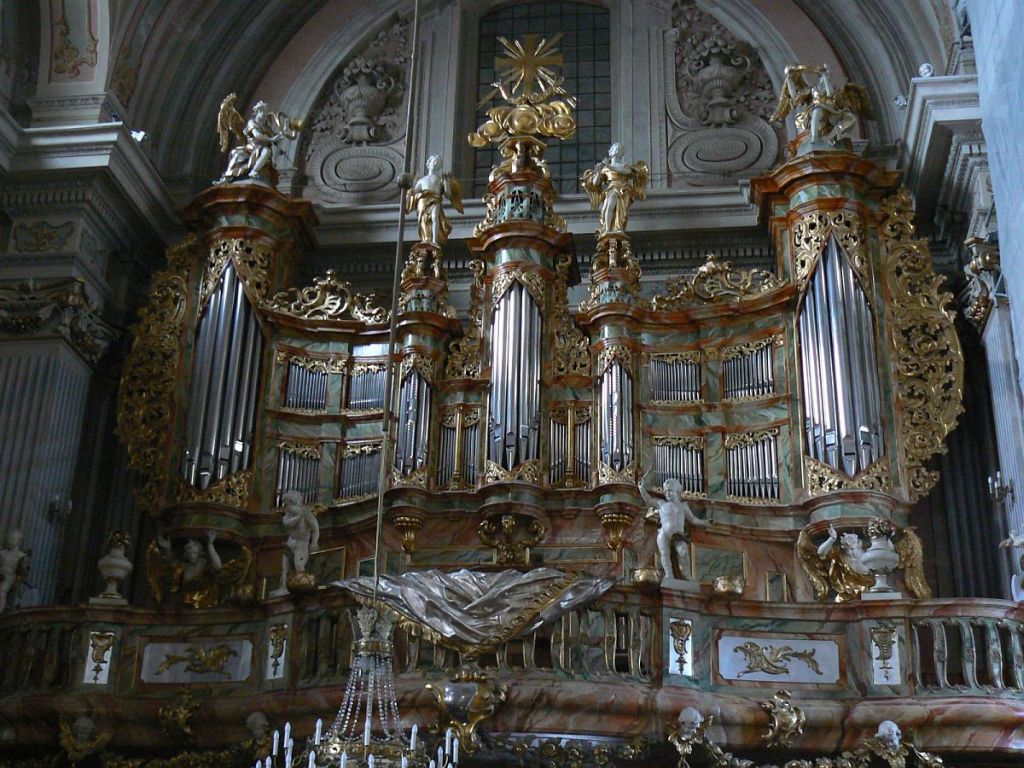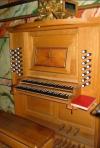Ausführliche Beschreibung der vorgewählten Orgel

Bild: Bert Wisgerhof
Warszawa, Polska (Województwo Mazowieckie) - Kościół Akademicki św. Anny
Gemeinde: Warszawa
Adresse: Krakowskie Przedmieście 68, Warszawa
Website: http://swanna.waw.pl/
Beschreibung nr.: 2009084.
Gebaut von: Pflüger Orgelbau (1992)
Technische Daten
Disposition
Hauptwerk (C-a'''): Gedackt 16', Principal 8', Gamba 8', Voce Umana 8', Spitzflöte 8', Octav 4', Flöte 4', Quint 2 2/3', Superoctav 2', Cornett 5 fach (8'), Mixtur 4 fach (1 1/3'), Trompete 8'.
Positiv (C-a'''): Gemshorn 8', Holzgedackt 8', Principal 4', Rohrflöte 4', Nasard 2 2/3' - halfdraw Sesquialter, Principal 2', Blockflöte 2', Quint 1 1/3', Sesquialter 2 fach, Scharff 4 fach (1'), Krummhorn 8', Tremulant, Glockenspiel.
Pedal (C-f'): Principalbass 16', Subbass 16', Octavbass 8', Gedacktbass 8', Choralbass 4', Mixtur 4 fach (2 2/3'), Posaune 16', Trompete 8'.
Koppeln: Hauptwerk - Positiv, Pedal - Hauptwerk, Pedal - Positiv.
Übrige Quellen

Bild: Bert Wisgerhof
Warszawa, Polska (Województwo Mazowieckie) - Kościół Akademicki św. Anny
Gemeinde: Warszawa
Adresse: Krakowskie Przedmieście 68, Warszawa
Website: http://swanna.waw.pl/
Beschreibung nr.: 2009084.
Gebaut von: Pflüger Orgelbau (1992)
| Jahr | Orgelbauer | Opus | Aktivität | 1753 | Paschalis Klein | Neubau | 1753 | Bartolmiej Sculz | Neubau | 1781 | Josef Janiczek | Restaurierung | 1852 | Mateusz Mielczarski | Umbau | 1900 | Spiegel Orgelbau | Neubau im alten Gehäuse | 1951 | Dominik Biernacki | Restaurierung | 1992 | Pflüger Orgelbau | Neubau im alten Gehäuse |
- The organ in the Kościół Akademicki św. Anny is one of the few historic organs in the city that survived World War II. The church building is an old monastery church of the Bernardine monks. In the years 1701-1707, Father Antony from Glogow, together with Brother Klemens from Sierpc, built an organ for the monastery church. This instrument was completely rebuilt and renewed in 1750-1753 by Paschalis Klein and Bartolmiej Sculz. The organ case dates from this time. In 1781 the organ was restored by Josef Janiczek. Mateusz Mielczarski renewed the instrument in 1851-1852. Karol and Albert Spiegel built a new romantic organ with pneumatic cone chests behind the historic front in 1900. After the war, the Biernacki company carried out a restoration in 1950-1951. A new console has also been installed. The church building is no longer a monastery church, but is used as an academic church of the University of Warsaw.
- Because a restoration was necessary and the pneumatic organ did not correspond to the eighteenth-century organ case, it was decided to have a completely new organ built in Baroque style by Pflüger Orgelbau. Consultants were Joachim Grubich and Hans Haselböck. The new organ has thirty stops on two manuals and pedal. It was put into service in 1992.
Technische Daten
| Anzahl Register pro Manual | |
| - Hauptwerk | 12 |
| - Positiv | 11 (10) |
| - Pedal | 8 |
| Gesamtzahl der Stimmen | 31 (30) |
| Tastentraktur | Mechanical |
| Registertraktur | Mechanical |
| Windlade(n) | Slider chests |
Disposition
Hauptwerk (C-a'''): Gedackt 16', Principal 8', Gamba 8', Voce Umana 8', Spitzflöte 8', Octav 4', Flöte 4', Quint 2 2/3', Superoctav 2', Cornett 5 fach (8'), Mixtur 4 fach (1 1/3'), Trompete 8'.
Positiv (C-a'''): Gemshorn 8', Holzgedackt 8', Principal 4', Rohrflöte 4', Nasard 2 2/3' - halfdraw Sesquialter, Principal 2', Blockflöte 2', Quint 1 1/3', Sesquialter 2 fach, Scharff 4 fach (1'), Krummhorn 8', Tremulant, Glockenspiel.
Pedal (C-f'): Principalbass 16', Subbass 16', Octavbass 8', Gedacktbass 8', Choralbass 4', Mixtur 4 fach (2 2/3'), Posaune 16', Trompete 8'.
Koppeln: Hauptwerk - Positiv, Pedal - Hauptwerk, Pedal - Positiv.
| Übrige dispositiondaten | |
|---|---|
| Mehrere dispositionen |
The specification of the Spiegel organ from 1900 was: Manual I: Bourdon 16', Pryncypal 8', Gedeckt 8', Gemshorn 8', Fugara 8', Salicet 8', Kwinta 5 1/3', Oktawa 4', Szpicflet 4', Kwinta 2 2/3', Kornet 2x, Mikstura 4x, Tremulant. Manual II: Pryncypal 8', Bourdon 8', Flet 8', Gamba 8', Aeolina 8', Traversflet 4', Fugara 4', Progresja 2-3x, Tremulant. Pedal: Pryncypalbas 16', Violonbas 16', Subbas 16', Kwintbas 10 2/3', Oktawa 8'. Koppel: Manual I - Manual II, Manual II - Manual I, Sub Manual I - Manual II, Super Manual I - Manual II, Pedal - Manual I, Pedal - Manual II, Super Manual I, Super - Manual II. 1 freie Kombination, 3 feste Kombination (p - f - tutti), Registercrescendo, Pedalautomat. |
| Literatur |
(PL) Varsovie Eglise académique Sainte-Anne. - Calender Organa Europæ - 1998 - Saint-Dié. |
- Pflüger Orgelbau
 |
